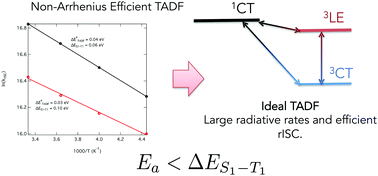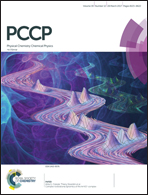Nonadiabatic coupling reduces the activation energy in thermally activated delayed fluorescence†
Abstract
The temperature dependent rate of a thermally activated process is given by the Arrhenius equation. The exponential decrease in the rate with activation energy, which this imposes, strongly promotes processes with small activation barriers. This criterion is one of the most challenging during the design of thermally activated delayed fluorescence (TADF) emitters used in organic light emitting diodes. The small activation energy is usually achieved with donor–acceptor charge transfer complexes. However, this sacrifices the radiative rate and is therefore incommensurate with the high luminescence quantum yields required for applications. Herein we demonstrate that the spin–vibronic mechanism, operative for efficient TADF, overcomes this limitation. Nonadiabatic coupling between the lowest two triplet states give rise to a strong enhancement of the rate of reserve intersystem crossing via a second order mechanism and promotes population transfer between the T1 to T2 states. Consequently the rISC mechanism is actually operative between initial and final state exhibiting an energy gap that is smaller than between the T1 and S1 states. This contributes to the small activation energies for molecules exhibiting a large optical gap, identifies limitations of the present design procedures and provides a basis from which to construct TADF molecules with simultaneous high radiative and rISC rates.



 Please wait while we load your content...
Please wait while we load your content...